Opportunity - the forgotten record holder
Behind the hype around the phenomenal landing of the Curiosity rover, many forgot that its predecessor did not stop working there. Spirit and Opportunity twin rovers (“Spirit” and “Opportunity”) landed on Mars back in 2004. Their creators counted on 90 Martian days (solos) of work, but they exceeded their resource tenfold. The connection with “Spirit” has already been lost, but “Opportunity” continues its work away from annoying journalists curling around “Curiosity”. But not in oblivion!
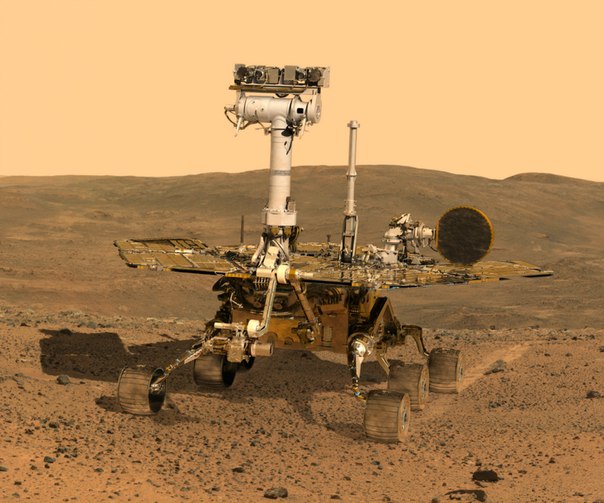
Opportunity visualization © Nick Sotiriadis 2011
Opportunity continues to operate for more than 3,120 solos. He set a new record for the work of human hands on the surface of Mars. The previous record belonged to the stationary Viking-1 landline, transmitting information 2245 solos. The Opportunity mileage exceeds 35 kilometers and it continues, with its inherent leisurelyness, approaching the next record - the distance traveled over the surface by a human apparatus outside the Earth. The record was set back in 1973 - Lunokhod-2 traveled exactly 37 kilometers. A couple of hundred meters separates Opportunity from the American record, which set Apollo Moonbuggy 17 - 35.89 km. The wind is blowing, the sun is shining, the wheels are spinning, and so far there is no reason to fear that both records will not be taken.

As for the wind, this is a different story. The rovers were predicted for a short century due to the dustiness of solar panels. But Mars gave NASA a gift in the form of short-term storms and frequent tornadoes - sand demons (dust devils). Together they took up cleaning the solar panels of the rovers and they rushed to the unplanned conquest of Mars.

The reason that interest in Opportunity has almost disappeared is that in the previous three years he simply went to the new goal of his research. After exploring the interesting Victoria Crater, there were no goals left for him, and he went to the 19-km marathon along the Meridiani Plateau, which he had already thoroughly studied. Three years without news and discoveries - everyone will be forgotten here.
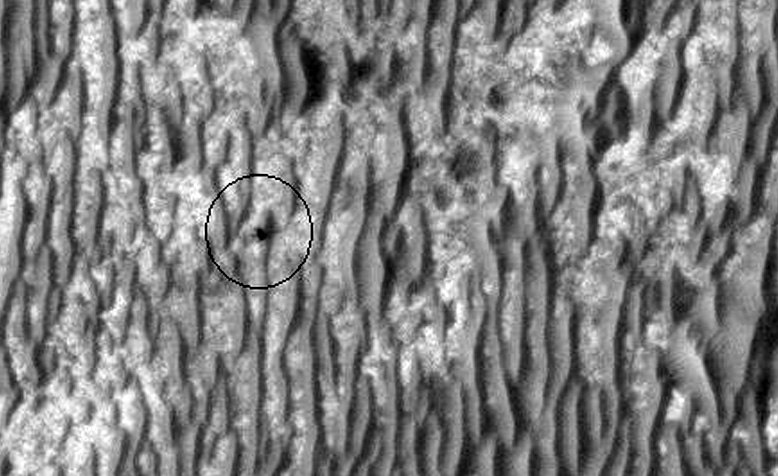
But his goal is promising - the Endeavor Crater. When the rover just landed, its main goal was to search for evidence of the existence in the history of Mars of periods when there were liquid water and free reservoirs on the planet. The first months of research showed that there the whole desert is in this evidence - balls of hematite.
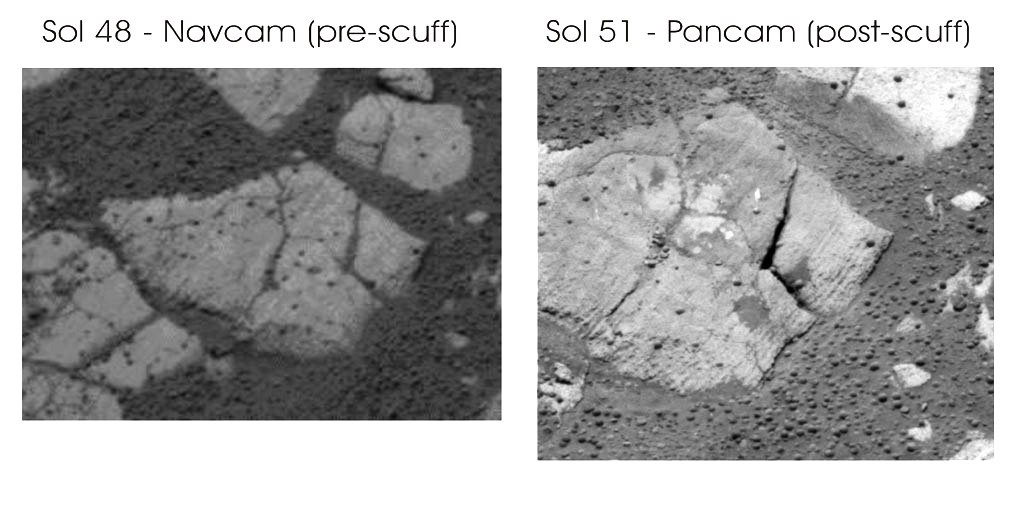
This is a type of iron ore that forms at the bottom of shallow ponds. But the prospects for Martian life, this discovery did not promise. In addition to hematite, called "blueberries", the soil had a high content of sulfates - substances that form in a very acidic aquatic environment. Some terrestrial extremophiles can survive in such an environment, but life does not self-organize in such water ( NASA does not seriously consider options for a non-carbon life form and does not engage in searches).
But observations of the CRISM satellite spectrometer showed that phyllosilicates — olivine-pyroxene clays — can lie deeper.
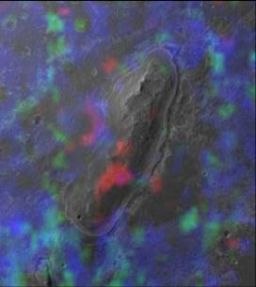
Cape York Hill. Red color is phyllosilicates, blue is sulfates.
The conditions for their formation are much more comfortable for life, the more they can save the remains of the representatives of the ancient fauna much better. Olivine and pyroxene are volcanic rocks that are almost ubiquitous on Mars. To get phyllosilicate you just need to add water. But such clays are very rare for the surface of Mars. Here we come to an explanation of why the Endeavor Crater is interesting.
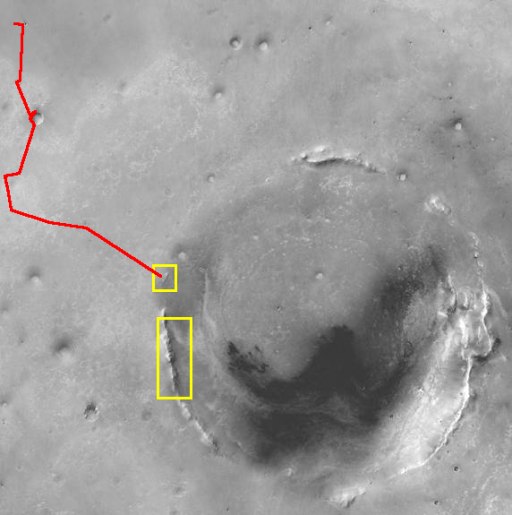
This is a very ancient 22 km long crater - it is more than a billion years old. At a later time, when the plain was formed, it was drawn in by sulfates and hematite, just like the entire Meridian plateau. But there were ring shafts! The impact of a meteorite raised the edges of the crater above the surrounding landscape, exposing the ancient layers. According to NASA, rocks that are much older than the surrounding plateau, including the desired clay, can be found in them. Therefore, Opportunity embarked on a long journey, which was diversified only by small craters, and meteors falling in the way.
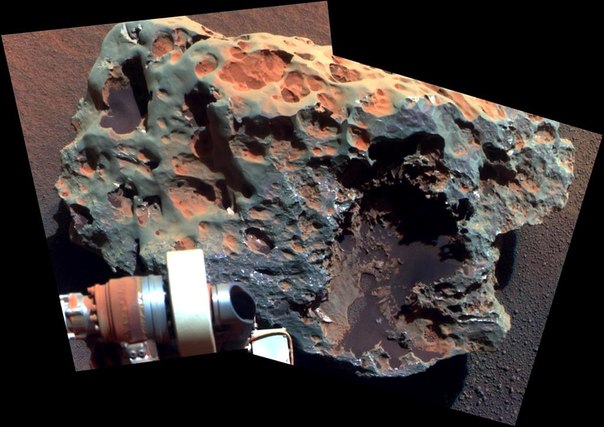
In the summer of 2011, he finally arrived at the first elevation related to the annular shaft of the crater. In fact, his second life began, since there was an object in front of him that was geologically different from everything that the rover had previously seen. The tasks have also changed: now, like Curiosity, the rover is looking for evidence of geological periods that were favorable for life. NASA representatives compared the arrival to the crater with a second landing.
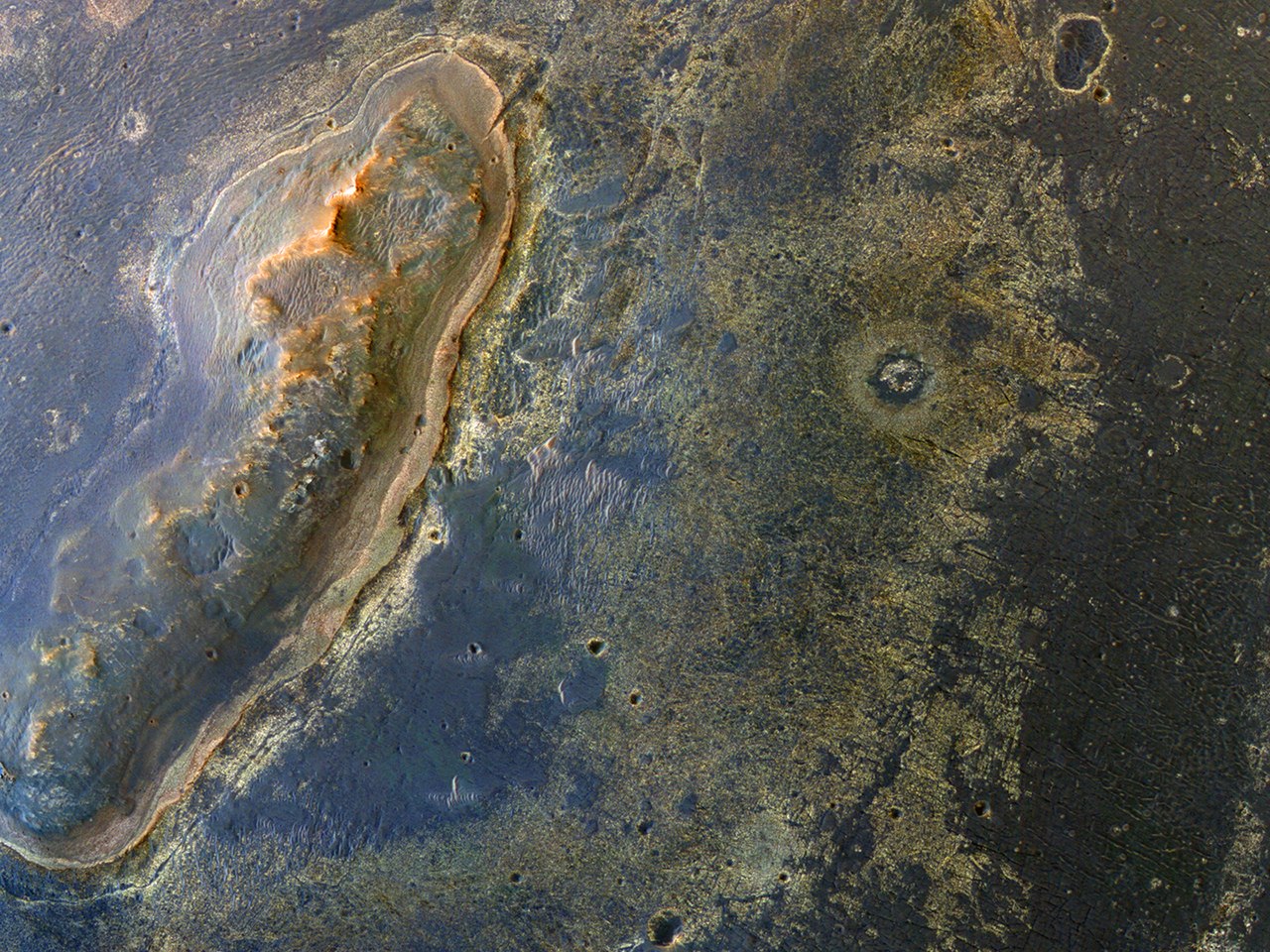
The oblong hill from which they decided to start exploring the crater was called Cape York. As soon as Opportunity approached him, the discoveries began. At the foot of the hill was found a gypsum vein. This was yet another proof of the water past of Mars, but it was still not the kind of water NASA would like, and carbon life forms.
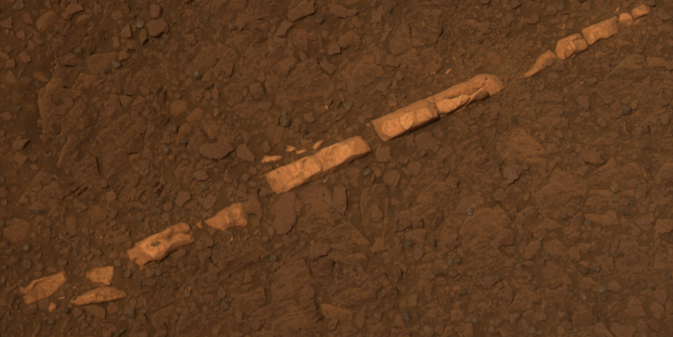
The phyllosilicates were waiting at the top, and they still had to get to it. But the ascent had to be postponed for six months - it was time for wintering. Rover, although metallic, but much of the animal is not alien to him. At night, he sleeps to save energy, and spends it only on heating. In winter, almost all energy is consumed for heating, and the rover is immobilized during the entire cold season. It is placed at an optimal angle to the winter sun and it hibernates.
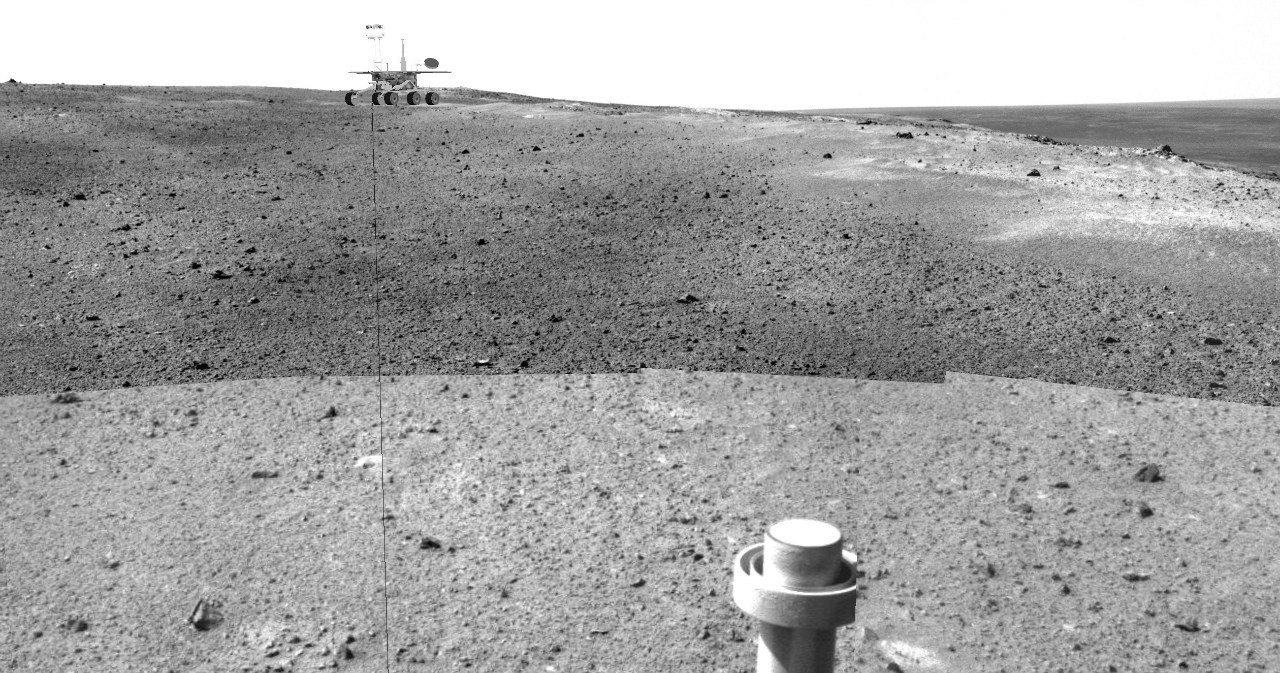
From January to May 2012, he did not move, but he took and transmitted a full 360-degree color panorama of the place called Grillie Haven. In August, after landing Curiosity, this panorama spread across social networks, and authorship was often attributed to the newcomer.
In the summer, the Opportunity continued to bypass Cape York, and in September began climbing.
And almost immediately I came across a sensation.
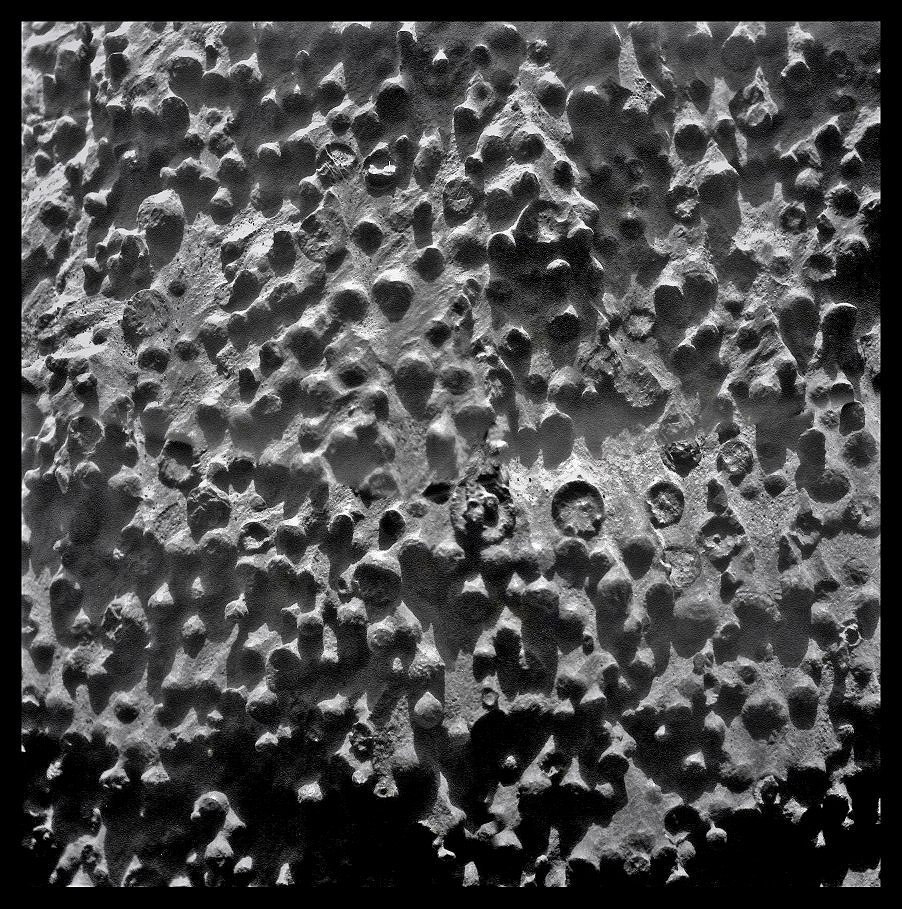
The exposure of the Kirkwood baffled scientists. Analysis of the rock showed a low iron content, so this “grape” is not at all the “blueberry” that the entire desert is strewn with. The balls enclosed in the rock have a heterogeneous structure, they have a hard shell and a soft filler. But what it is NASA has not been decided. According to the working version, this is such and such a result of volcanic activity - the structure of the "shell" resembles volcanic glass. It may also be the result of impact - from the explosion that generated the entire crater.
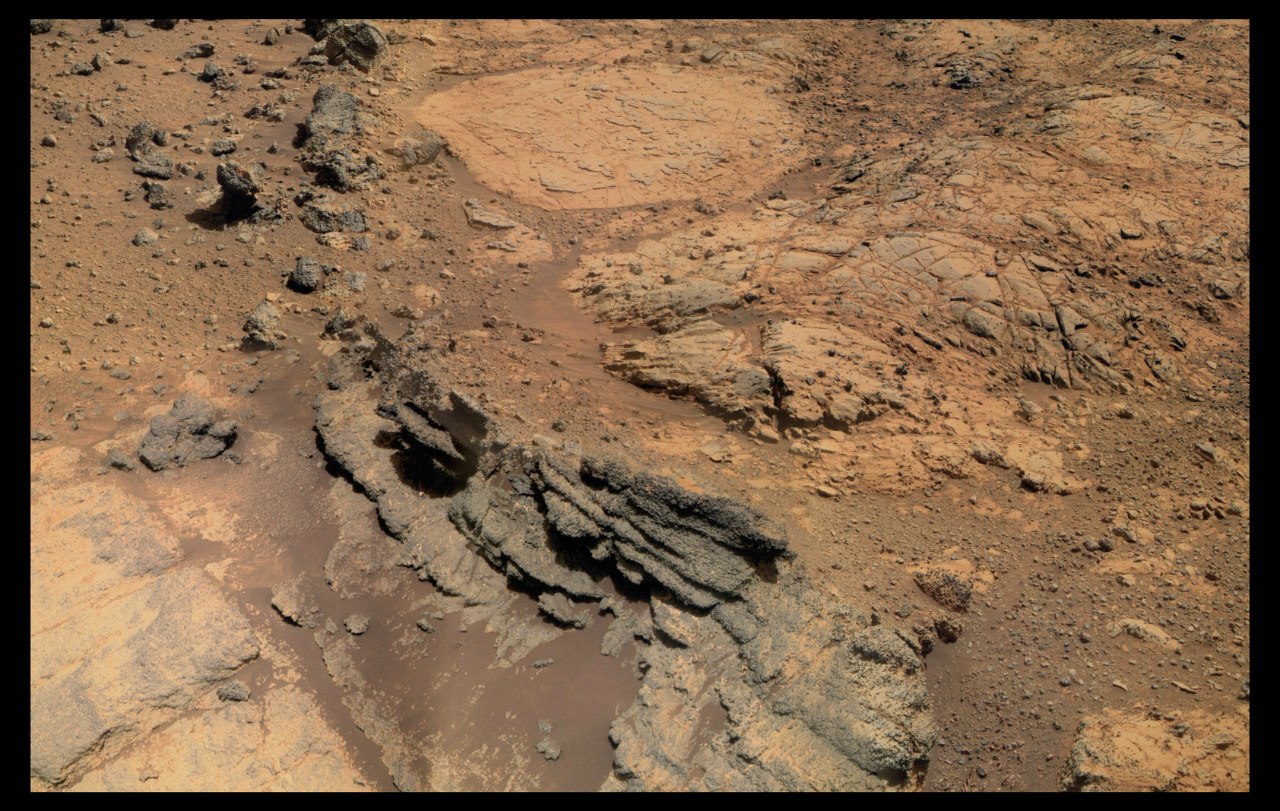
The upper part of Cape York was named Matievich Hill, in memory of Jake Matievich - an engineer who worked on all NASA rovers. The study of Matievich’s hill began in October and continues to this day. Since there are a lot of rock outcrops on it, it was decided to go around it in a circle studying each stone, so as to compile the most detailed geological picture of the place.
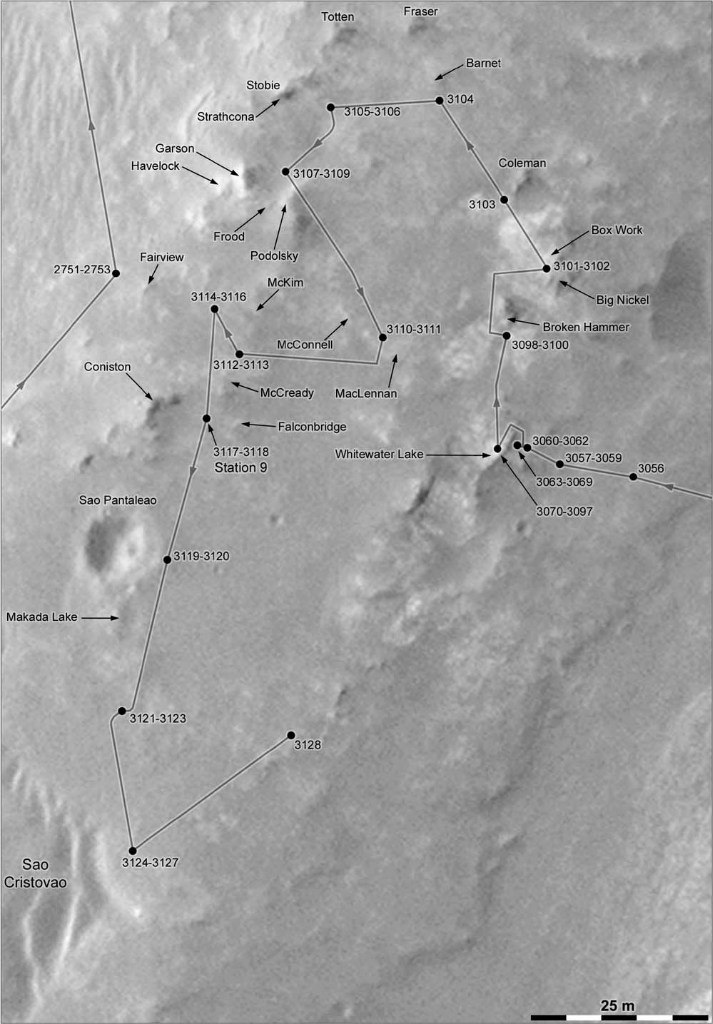
Map © Phil Stooke
NASA stretches the fun, and sequentially examines all the oncoming stones, resisting the temptation to rush immediately to the deposits of phyllosilicates. On the hill and without them there is enough interesting. For example, when studying satellite images, one can notice geometrically correct figures that on Earth would most likely turn out to be some kind of archaeological monument.
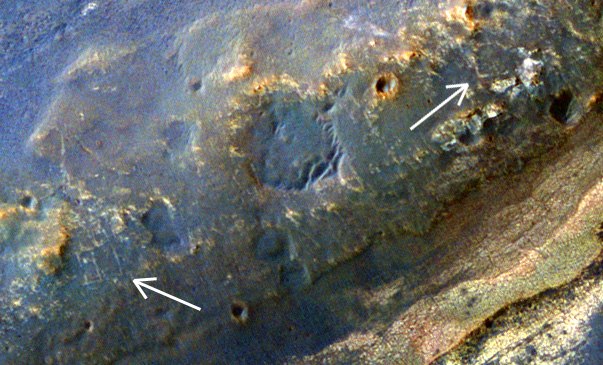
But there are no full-time archaeologists at NASA, so they give a geological explanation for such structures. They are called "boxwork", they can be both multi-meter scale, and centimeter. Such were just discovered where a large “boxwork” was visible from the satellite.
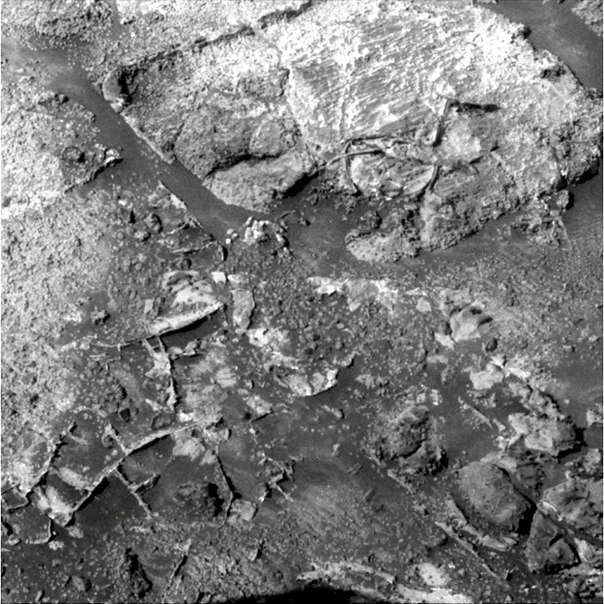
Their origin is explained by crystallization of salt in the silt of a drying reservoir. For example, ordinary sodium chloride NaCl has a cubic form of crystals, so they line up in rectangular structures. On Earth, you can observe a similar effect on drying out salt lakes, for example, such as the famous Groom Lake.
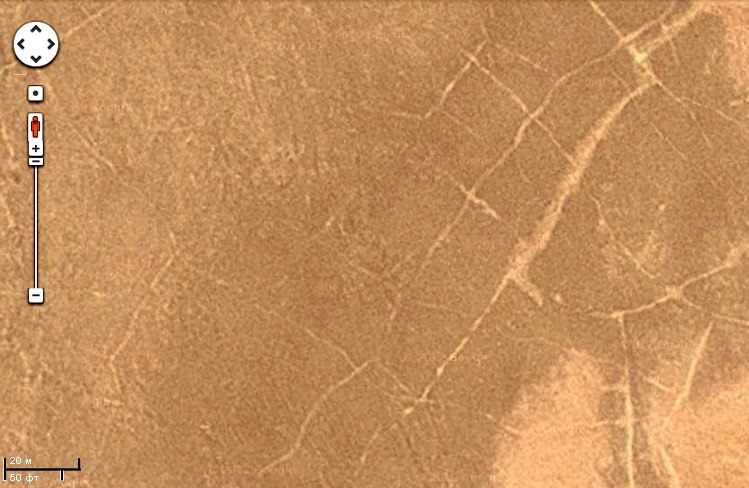
However, it may be calcite, which, under the influence of water, filled cracks in some rock, and then it collapsed from erosion.
The NASA team claims to go to the phyllosilicate deposits only after it closes the ring around Matievich’s hill.

Today, the rover has problems with the right wheel engine; the arm of the manipulator is broken, because of which it is impossible to move the “arm” to the stowed position; one heater is faulty; batteries produce about half the energy from the level at the time of landing. But the operators of the Mars rover are full of optimism and are ready to please us more than once with loud discoveries that can compete with the results of Curiosity.
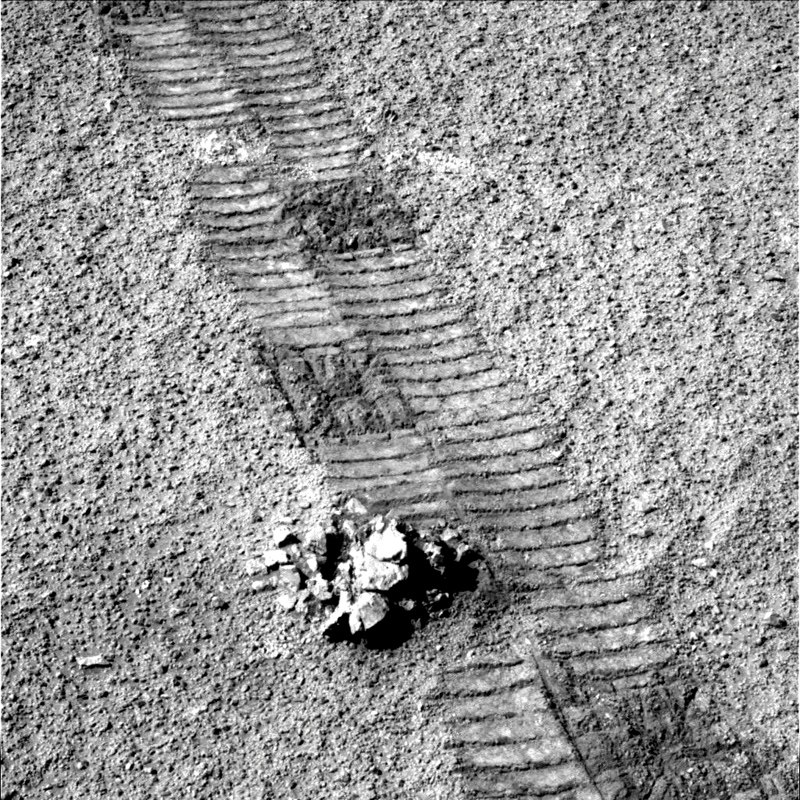
I borrowed some of the photos from the VKontakte group The Best from Mars .
part of the blog www.planetary.org/blogs/emily-lakdawalla

Opportunity visualization © Nick Sotiriadis 2011
Opportunity continues to operate for more than 3,120 solos. He set a new record for the work of human hands on the surface of Mars. The previous record belonged to the stationary Viking-1 landline, transmitting information 2245 solos. The Opportunity mileage exceeds 35 kilometers and it continues, with its inherent leisurelyness, approaching the next record - the distance traveled over the surface by a human apparatus outside the Earth. The record was set back in 1973 - Lunokhod-2 traveled exactly 37 kilometers. A couple of hundred meters separates Opportunity from the American record, which set Apollo Moonbuggy 17 - 35.89 km. The wind is blowing, the sun is shining, the wheels are spinning, and so far there is no reason to fear that both records will not be taken.

As for the wind, this is a different story. The rovers were predicted for a short century due to the dustiness of solar panels. But Mars gave NASA a gift in the form of short-term storms and frequent tornadoes - sand demons (dust devils). Together they took up cleaning the solar panels of the rovers and they rushed to the unplanned conquest of Mars.

The reason that interest in Opportunity has almost disappeared is that in the previous three years he simply went to the new goal of his research. After exploring the interesting Victoria Crater, there were no goals left for him, and he went to the 19-km marathon along the Meridiani Plateau, which he had already thoroughly studied. Three years without news and discoveries - everyone will be forgotten here.

But his goal is promising - the Endeavor Crater. When the rover just landed, its main goal was to search for evidence of the existence in the history of Mars of periods when there were liquid water and free reservoirs on the planet. The first months of research showed that there the whole desert is in this evidence - balls of hematite.

This is a type of iron ore that forms at the bottom of shallow ponds. But the prospects for Martian life, this discovery did not promise. In addition to hematite, called "blueberries", the soil had a high content of sulfates - substances that form in a very acidic aquatic environment. Some terrestrial extremophiles can survive in such an environment, but life does not self-organize in such water ( NASA does not seriously consider options for a non-carbon life form and does not engage in searches).
But observations of the CRISM satellite spectrometer showed that phyllosilicates — olivine-pyroxene clays — can lie deeper.

Cape York Hill. Red color is phyllosilicates, blue is sulfates.
The conditions for their formation are much more comfortable for life, the more they can save the remains of the representatives of the ancient fauna much better. Olivine and pyroxene are volcanic rocks that are almost ubiquitous on Mars. To get phyllosilicate you just need to add water. But such clays are very rare for the surface of Mars. Here we come to an explanation of why the Endeavor Crater is interesting.

This is a very ancient 22 km long crater - it is more than a billion years old. At a later time, when the plain was formed, it was drawn in by sulfates and hematite, just like the entire Meridian plateau. But there were ring shafts! The impact of a meteorite raised the edges of the crater above the surrounding landscape, exposing the ancient layers. According to NASA, rocks that are much older than the surrounding plateau, including the desired clay, can be found in them. Therefore, Opportunity embarked on a long journey, which was diversified only by small craters, and meteors falling in the way.

In the summer of 2011, he finally arrived at the first elevation related to the annular shaft of the crater. In fact, his second life began, since there was an object in front of him that was geologically different from everything that the rover had previously seen. The tasks have also changed: now, like Curiosity, the rover is looking for evidence of geological periods that were favorable for life. NASA representatives compared the arrival to the crater with a second landing.

The oblong hill from which they decided to start exploring the crater was called Cape York. As soon as Opportunity approached him, the discoveries began. At the foot of the hill was found a gypsum vein. This was yet another proof of the water past of Mars, but it was still not the kind of water NASA would like, and carbon life forms.

The phyllosilicates were waiting at the top, and they still had to get to it. But the ascent had to be postponed for six months - it was time for wintering. Rover, although metallic, but much of the animal is not alien to him. At night, he sleeps to save energy, and spends it only on heating. In winter, almost all energy is consumed for heating, and the rover is immobilized during the entire cold season. It is placed at an optimal angle to the winter sun and it hibernates.

From January to May 2012, he did not move, but he took and transmitted a full 360-degree color panorama of the place called Grillie Haven. In August, after landing Curiosity, this panorama spread across social networks, and authorship was often attributed to the newcomer.
In the summer, the Opportunity continued to bypass Cape York, and in September began climbing.
And almost immediately I came across a sensation.

The exposure of the Kirkwood baffled scientists. Analysis of the rock showed a low iron content, so this “grape” is not at all the “blueberry” that the entire desert is strewn with. The balls enclosed in the rock have a heterogeneous structure, they have a hard shell and a soft filler. But what it is NASA has not been decided. According to the working version, this is such and such a result of volcanic activity - the structure of the "shell" resembles volcanic glass. It may also be the result of impact - from the explosion that generated the entire crater.

The upper part of Cape York was named Matievich Hill, in memory of Jake Matievich - an engineer who worked on all NASA rovers. The study of Matievich’s hill began in October and continues to this day. Since there are a lot of rock outcrops on it, it was decided to go around it in a circle studying each stone, so as to compile the most detailed geological picture of the place.

Map © Phil Stooke
NASA stretches the fun, and sequentially examines all the oncoming stones, resisting the temptation to rush immediately to the deposits of phyllosilicates. On the hill and without them there is enough interesting. For example, when studying satellite images, one can notice geometrically correct figures that on Earth would most likely turn out to be some kind of archaeological monument.

But there are no full-time archaeologists at NASA, so they give a geological explanation for such structures. They are called "boxwork", they can be both multi-meter scale, and centimeter. Such were just discovered where a large “boxwork” was visible from the satellite.

Their origin is explained by crystallization of salt in the silt of a drying reservoir. For example, ordinary sodium chloride NaCl has a cubic form of crystals, so they line up in rectangular structures. On Earth, you can observe a similar effect on drying out salt lakes, for example, such as the famous Groom Lake.

However, it may be calcite, which, under the influence of water, filled cracks in some rock, and then it collapsed from erosion.
The NASA team claims to go to the phyllosilicate deposits only after it closes the ring around Matievich’s hill.

Today, the rover has problems with the right wheel engine; the arm of the manipulator is broken, because of which it is impossible to move the “arm” to the stowed position; one heater is faulty; batteries produce about half the energy from the level at the time of landing. But the operators of the Mars rover are full of optimism and are ready to please us more than once with loud discoveries that can compete with the results of Curiosity.

I borrowed some of the photos from the VKontakte group The Best from Mars .
part of the blog www.planetary.org/blogs/emily-lakdawalla
